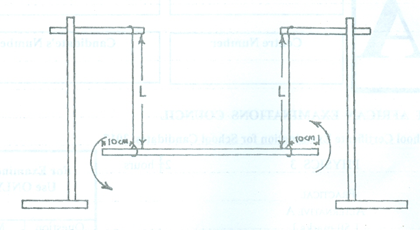Alternative A
Question 1A

- Set up the apparatus as illustrated above ensuring that the strings are permanently 10 cm from either of the rule.
- Measure and record the L = 80 cm of the two strings.
- Hold both ends of the rule and displace the rule slightly, then release so that it oscillates about a vertical axis through its centre.
- Determine and record the time t for 10 complete oscillations.
- Determine the period T of oscillations.
- Evaluate log T and log L.
- Repeat the procedure for four other values of L = 70 cm, 60 cm, 50 cm and 40 cm.
- Tabulate your readings.
- Plot a graph with log T on the vertical axis and log L on the horizontal axis.
- Determine the slope, s, and the intercept, c on the vertical axis of the graph.
- State two precautions taken to ensure accurate results.
(b) (i) Define simple harmonic motion
(ii) Determine the value of L corresponding to t = 12 s from the graph in 1(a).
Observation
Part (a) Candidates performance was fair. Many candidates did not pay adequate attention to instructions and end up losing marks. Some candidates determined log t instead of log T as required. Majority of the candidates could not evaluate log T and log L correctly to the required number of d.p.
Part (b) The question was poorly attempted. Candidates could not define simple harmonic motion correctly. (ii) Few candidates that got the graph right were able to determine the value for L correctly on the graph.
Candidates were expected to:
- measure and record five values of L to at least 1 d.p in cm
- read and record five values of t to at least 1 d.p in seconds and in trend
- evaluate five values of T to at least 2 d.p in seconds
- evaluate five values of log L to at least 3 s.f
- evaluate five values of log T to at least 3 d.p
- show composite table containing at least L, t, T, log L and log T
- Both axes correctly distinguished
- plot a graph using reasonable scales
- draw line of best fit
- determine the slope and intercept of the graph
- state any two of the following precautions.
e.g.
- Ensured strings were tight/firm
- Ensured supports of pendulum were rigid
- Avoided parallax error on meter rule/stopwatch/stop clock
- Zero error was noted and corrected on metre rule/stopwatch/stop clock
- Ensured smooth and regular oscillations in a horizontal plane
- Repeated readings shown on table
- Avoided draught
In part b, the expected answers are:
b(i) Simple harmonic motion is the motion of a body whose acceleration is always directed
